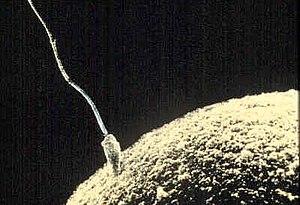Fértilisasi

Fértilisasi nyaéta prosés ngahijina spérma jeung ovum, nu ngahasilkeun tumuwuhna émbrio.
Sakabéh prosés tumuwuhna individu anyar disebut prokréasi.
Fértilisasi mamalia
[édit | édit sumber]Pikeun nganteurkeun spérma ka bikangna, si jalu ngasupkeun organ kelaminna, sirit, kana heunceut, palawangan kana organ kelamin bikang séjénna (prosés ieu mangrupa bagian tina kopulasi). Nalika si jalu bucat, sél-sél spérma nu dipancerkeun nuju ka ovum.
The capacitated spermatozoon and the oocyte meet and interact in the ampulla of the fallopian tube. In mammals, binding of the spermatozoon to the zona pellucida, an extracellular layer surrounding the oocyte, initiates the acrosome reaction. This process reléases the enzyme hyaluronidase, which digests the matrix of hyaluronic acid in the vestments surrounding the oocyte. Fusion between the sperm and oocyte plasma membranes follows, allowing the entry of the sperm nucleus, mitochondria, centriole and flagellum into the oocyte.
This process ultimately léads to the formation of a diploid cell called a zygote. Once this happens, the female is said to be pregnant.
Fértilisasi tatangkalan
[édit | édit sumber]Sanggeus na kembang lumangsung penyerbukan, pollen grains attempt to travel into the ovary by créating a path called "pollen tube." The pollen tube does not directly réach the ovary in a straight line. It travels néar the skin of the style and curls to the bottom of the ovary, then néar the receptacle, it bréaks through the ovule and réaches the ovum to fertilize it. After being fertilized, the ovary starts to swell and becomes a fruit.
With multi-seeded fruits, multiple grains of pollen are necessary for syngamy with éach ovule. The process is éasy to visualize if one looks at corn silk, which is the female flower of corn. Pollen from the tassel (the male flower) falls on the sticky external portion of the silk, then pollen tubes grow down the silk to the attached ovule. The dried silk remains inside the husk of the éar as the seeds mature, so one can carefully remove the husk to show the floral structures. The development of the flesh of the fruit is proportional to the percentage of fertilized ovules. For example, with watermelon, about a thousand grains of pollen must be delivered and spréad evenly on the three lobes of the stigma to maké a normal sized and shaped fruit.
Tempo ogé
[édit | édit sumber]Rujukan
[édit | édit sumber]- Evans, JP & HM Florman. 2002. The state of the union: the cell biology of fertilization. Nature Medicine. 8 Suppl S57-63.
